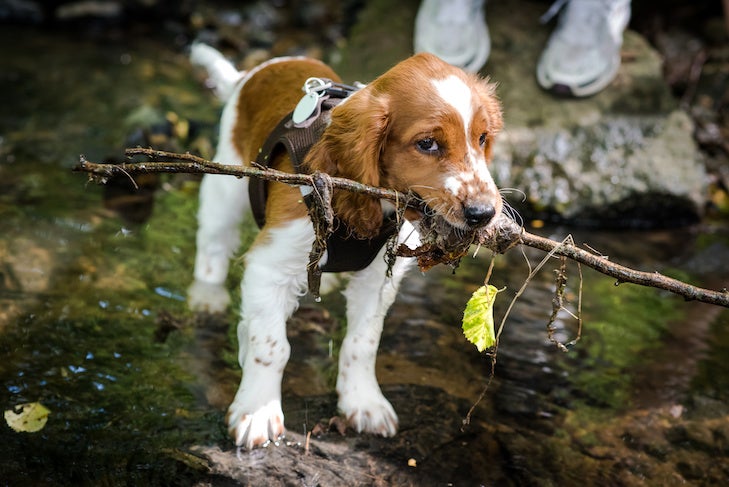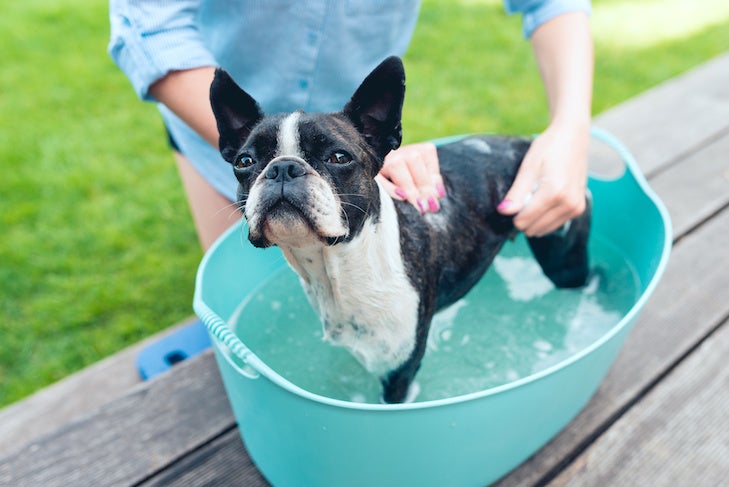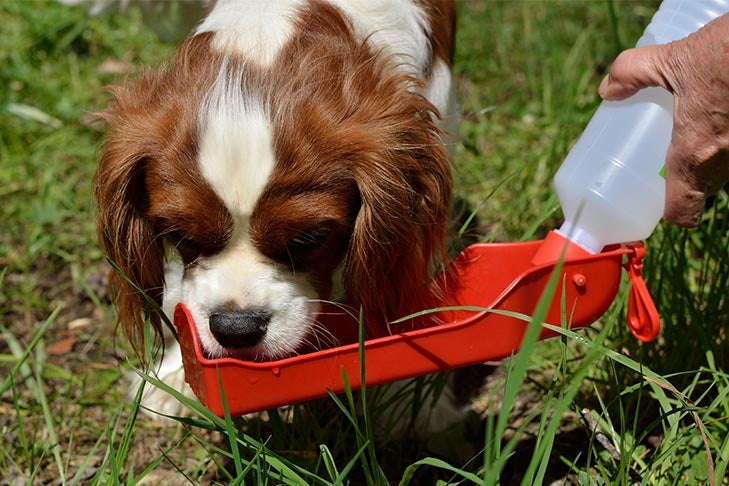
Do you follow the three “R’s” of environmental responsibility: Reduce, reuse, and recycle? As a dog owner, there are lots of ways to go green. You can start with the basics, like picking up poop, and even change the way you care for your dog by choosing environmentally friendly products. You and your eco-friendly dog will be well on your way with these 10 tips.
1. Go green with waste.
It’s a fact of dog ownership that your dog will poop, and you’ll have to dispose of that poop. Dog waste may contain pathogens such as bacteria, viruses, and parasitic worms that can be transmitted to humans who are gardening in contaminated soils or swimming in infected water. The phosphorus and nitrogen in dog excrement can be harmful to marine life and contribute to toxic algae.
Use biodegradable, compostable bags for dog waste. Then simply throw it all in the trash. Flushing dog feces down the toilet, without the bag, of course, is the best way to dispose of it.
If you want to take an additional step, you can compost dog waste. The National Resources Defense Council (NRDC) describes exactly how to do this. Note that dog waste compost cannot be used on vegetable, fruit, or any edible plants.
2. Buy food and other pet supplies in bulk.
This reduces trips to the store and the amount of packaging you contribute to the landfill. Pay attention to packaging materials, and try to buy products packaged in recycled or recyclable materials. Store food and treats in reusable storage containers instead of in plastic bags.
3. Support environmentally conscious manufacturers.
Support environmentally conscious manufacturers by buying eco-friendly pet products, such as those made from recycled materials. In fact, before you buy, see if friends or family can offer used leashes, collars, crates, and other products. It not only saves money, but it also keeps those items from ending up in a landfill. Just be sure that the hooks and attachment rings on any reused leashes and collars are still in good, strong condition.

4. Use environmentally friendly shampoo and grooming products.
There are lots of products on the market that are made of plant-based, natural, or sustainably produced materials.
5. Beware of toxic flea and tick prevention products.
Some flea and tick preventatives have harmful chemicals that leave residue on your dog’s fur and around the house. According to the NRDC, the most dangerous ingredients are tetrachlorvinphos and propoxur. You should also avoid amitraz and permethrin. Read instructions thoroughly before using and always use disposable gloves.
Ask your veterinarian about oral flea-prevention, and if you must use topical treatments, ask about those that have plant-based ingredients or safer chemicals, such as s-methoprene or pyriproxyfen.
A word of caution from the NRDC, though: There is little research to prove how well “natural” materials, such as rosemary oil, cedarwood, or peppermint work. Some plant and herb-based products have been linked to allergies in people and dogs. These products can also cause severe inflammation if placed directly on skin surfaces and potentially toxic reactions if directly placed in or around the nose and mouth.
Take preventive measures against fleas and ticks. Bathe and groom your dog regularly, and use a fine-toothed comb on his coat often to remove fleas.
Wash his bedding in hot water, wipe down surfaces often, and vacuum the floor and all soft furnishings frequently, emptying and discarding the contents frequently.
6. Get creative with toys.
When you buy toys, look for those made of recycled or biodegradable materials. An even better option is to make your own dog toys. It’s a handy way to use up scraps of yarn or fabric, old T-shirts, and other items you’d probably throw away. Whenever practical, wash old toys instead of throwing them away.

7. Give away, don’t throw away.
Animal shelters can make great use of old towels, pillows, and toys your dog isn’t interested in. Shelters also welcome gently used food and water dishes, leashes and collars, brushes and grooming tools, and beds.
8. Bake, don’t buy.
Think of all the packaging waste generated every time you purchase another box or bag of treats. Homemade dog treats can be healthier for your dog, too.
9. Feed your dog safely.
Plastic bowls are porous and prone to gouges and cracks. They may likely contain bisphenol A (BPA), which is a synthetic used in epoxy resin and plastics that are potentially harmful. Although recent studies disagree, with so many other materials to choose from, it’s wise to avoid plastic feeding bowls.
Your best option is stainless steel, which is nonporous, easy to sanitize in the dishwasher, rust-resistant, and doesn’t leach chemicals. Glass and ceramic bowls are better than plastic, however, since dog dishes don’t have to be certified as food-safe the way those made for humans do, they may contain traces of lead or other chemicals.
10. Go digital, save a tree.
Encourage your veterinarian’s office to email treatment plans and bills instead of printing them. They may even be able to take advantage of digital payment technology, for example, Stripe, Square, PayPal, and Apple Pay.
These are just some of the ways your dog, with your help, can leave a smaller carbon paw print on the planet. As you pay more attention to the products you use, the alternatives to harmful ingredients, and the amount of waste that life as a dog owner produces, you may find even more ways to go green with your dog.

